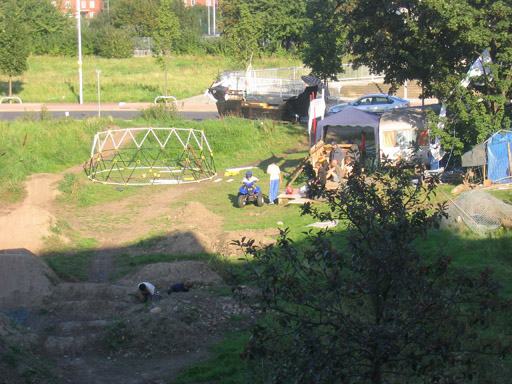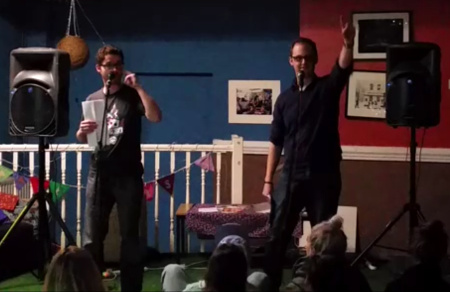MMU’s rise in Green Table proves controversial in Hulme
Article published: Friday, June 25th 2010
Manchester Metropolitan University is the second highest climber in the Green League table of UK universities published by People and Planet. Out of the 141 universities and colleges of higher education (HE) in the table Man Met has moved from 91st place in 2007 to 27 this year. However, some Hulme residents are less than impressed in light of the long-running campaign to stop MMU building on Birley Fields.
However, some Hulme residents are less than impressed in light of the long-running campaign to stop MMU building on Birley Fields.

Birley Fields
The table compares environmentally sound factors in HE institutions including environmental policy, Fairtrade status, energy use, waste and ethical investments.
Man Met has been lauded by People and Planet for taking environmental initiatives such as investing £650,000 in heating controls, photovoltaic solar panels (which save around 22 tonnes of CO2 per year) and plans to include a ‘green’ business school and controversial low carbon campus in Hulme. MMU also recently received a Carbon Trust Standard accreditation and is a Fairtrade supplier.
MMU Director of Services Mary Heaney said: “This is a magnificent achievement and a superb recognition of the Environment Team and the commitment of our student and staff community.”
However, criticism has been levelled at MMU for developing its new campus on Birley Fields in Hulme, one of very few green spaces in the area. Manchester City Council had originally planned to use the space for office blocks, a hotel and a car show room which didn’t prove popular with residents. In the last couple of years, the plan was made to build a new MMU campus in Hulme, after meeting opposition to plans to extend the campus in Didsbury.
Amid anger from locals that there had been a lack of serious consultation over the plans came the revelation that the Council planned to give the land to MMU for free, justified “on the basis of the economic and regeneration benefits of the development”. Despite fierce opposition, MMU was given £28.5 million of funding towards the £150 million development by various public bodies, including the transfer of £10 million of land by the Council back in March 2010.
MMU estimated in 2009 that the campus would generate £76 million into the local economies of Hulme and Moss Side, but failed to allay concerns among locals that Hulme would be turned into another Fallowfield, where the high student population has led to exclusion for local residents. News that half of the buildings would be residential halls only fuelled this fear.
“Strategically, the Council see Hulme as an extension to the city centre with scant consideration for the impact on the community. It’s worth noting too that the angle of elevation in artist impressions fails to show the dominance the large buildings will have on the eye from ground level,” said Steve Durrant of Hulme Green Party and Our Hulme.
Behind MMU’s hype about what it said would be the “greenest campus in the UK”, local concerns appeared to be getting ignored, and soon the university said it was in the process of axing 127 support staff, as it became clear it was facing significant financial hardship. MMU then announced the new campus would have to be progressed in stages. Campaigners became increasingly concerned that this would mean the profitable parts, such as accommodation, would get prioritised at the expense of promised community projects.
“Green need not be expensive,” said Durrant, “however, given that there is no requirement for the ‘green side’ and financial difficulties at the MMU, I am increasingly sceptical that their grand-sounding eco-ambitions will have the necessary underpinning and financial commitment.”
Joe Beech
More: Education, Environment, News
Comments
-
If our Institutions were to be compared to Western European institutions they would rank near the bottom. The MMU has made improvements but these are really nothing more than tokenism. As for their plans for Birley Fields at the so-called consultations they admitted their plans for a greener campus depended on funding. This was before they started making staff redundant and the emergency budget. We in Hulme have been promised all sorts to only get nothing. There are plenty of brownfield sites to build the campus as well as all the empty office blocks which could be utilised.
Comment by Patrick Sudlow on June 27, 2010 at 1:03 pm -
Colleagues may have read the recent announcement about
Comment by a.p freer on August 3, 2010 at 12:59 pm
withdrawal of NWDA funding from a number of projects including
Birley Fields. It is the case that 8.5M GBP of funding has been
…withdrawn, but this does not de-rail the project or undermine
the long-term benefits that a consolidation onto Birley Fields
will achieve. The University is committed to the Birley Fields
development and is in discussion with HEFCE and Manchester City
Council to proceed with the project. I am convinced that
the longer term academic, community and environmental benefits
are so great that a way will be found to deliver the ambitious
vision for the campus. The need for an integrated campus is
even greater within a resource constrained future. -
The reality here is that MMU are seeking to build five blocks of student flats and a multi-store car park (funded by private investors). There will be no benefits for local residents.
Plans for the campus are ever shrinking. Also, there is no sports hall; it was this feature which gained the highest approval?
Comment by Insider on August 9, 2010 at 9:19 am
The comments are closed.



